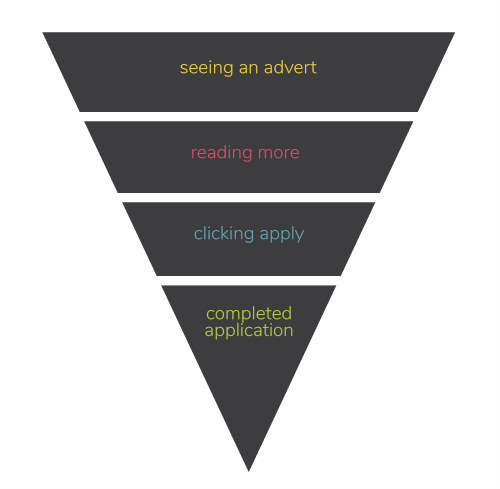4 tips for evaluating your recruitment marketing metrics
Looking to improve and better understand your recruitment marketing metrics? It helps to start by evaluating the full candidate journey – from awareness to completed application.
For the purposes of this blog, the assumption is that you’re using a standard method of advertising across job boards – for example Monster, Indeed or LinkedIn.
Widely used in general marketing practice is the marketing funnel. The same principles of this funnel also apply to recruitment marketing and advertising. To run an effective recruitment campaign, you should be looking to see that as few people as possible fall out of the funnel in the different stages towards reaching your end goal – a completed application.

Funnel stage: Advertising/awareness
Measuring success: Look to the number of views you are receiving for your adverts as the starting point of measuring the recruitment marketing metrics.
Each job advert will be different – if you’re advertising a general administration or customer support role, you will see these get some of the highest amount of views.
If you’re recruiting a molecular biologist, you’ll need to adjust your expectations.
You should have some strong benchmarks of what constitutes a good performance for both your easy and hard to recruit roles so you can evaluate performance.
Methods to improve: If you are not getting enough views of your advert, it may be worth sponsoring the advert in order to appear in the first page of searches.
If you are recruiting a niche role, consider searching out a more specific place to locate your advert.
Where does your target audience spend time? Are they members of a professional organisation?
Is there an influential figure or body in their specialism?
Consider advertising a role where you are most likely to get the right people to see it.
It does take a bit of research to establish but could significantly improve the number of views and engagement.
Funnel stage: Reading more/interest
Measuring success: Click through rates (CTR) tell you the number of people that upon viewing your advert, have been compelled to engage and take further action and click through.
As before, different roles will have different benchmarks of success.
Look through the analytics of previous similar adverts that had a good number of candidates apply to get a feel for the metrics that you can compare against.
Methods to improve: If you are not getting enough interaction with your advert (lots of views but of those viewers, very few are taking action to click) then it may be that you need to consider the snapshot of information in the job advert preview.
Is the salary competitive with the other roles appearing when you search out similar? Do you entice the applicant to find out more in the first 1-2 sentences of the listing?
Funnel stage: Clicking apply/evaluation
Measuring success: Proportion of those reading that choose to apply. If you have 200 click throughs to your advert, but only 2 people are clicking apply – this is a 1% conversion rate, which is very poor.
A strong conversion rate will be highly variable depending on your industry and the type of role you are advertising, so you need to be able to benchmark based on your own track records of success.
Methods to improve: Starting with the obvious – proofreading your adverts, maintaining a good level of spelling and grammar (nothing is more off putting than a lazy copy and paste job).
Try to bring your employer branding into the mix and reflecting your organisation in the tone and style of your advert.
Create a candidate persona for those in the different business areas that you are recruiting into and come up with a story for them.
Who are they, where do they look for jobs, why do they want to move roles, who influences their decision making, what are their key skills, what really sells a job to them?
Funnel stage: Completing application/conversion
Measuring success: Proportion of people clicking apply, going through to your ATS and completing their application. Not everyone that clicks through to apply will finish an application, and you shouldn’t want them to.
Smart applicant tracking systems will feature upfront ‘killer questions’ that deter those unqualified to apply.
Methods to improve: Is your application process well designed? Does your candidate upload a CV early on and have the smart form already complete most of the application for them?
All too often, a poorly designed ATS will leave candidates frustrated – rekeying their answers and rectifying the mistakes of an applicant tracking system that hasn’t pulled the detail into the correct place.
Does your ATS have too many mandatory fields, is it designed to be used in another country?
It can be very frustrating to have American education fields for applicants in the UK, for example.
Try your application journey yourself and see how far you get. Getting your ATS built from scratch is a sure enough way of making sure it is tailored to your applicants’ needs.
Overall, it is imperative to examine each phase of recruitment in order to establish how your recruitment marketing metrics relate to one another and increase overall applications. Each individual set of data tells a story, it’s up to you to determine what that story is telling you about the strengths and weaknesses of your current recruitment marketing strategy.
Read more:
The Hireserve ATS reporting suite
How to improve candidate experience


